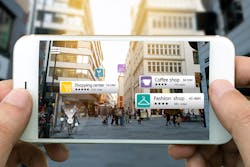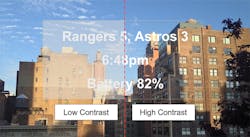The real world is great, but augmented-reality (AR) technology can make it even better—more fun, informative, productive, and educational. While wearable AR glasses for consumers aren’t here yet, the good news is that all of the apps and tools for smartphone-based AR have paved the way for an easy migration to next-generation apps on AR glasses.
In a way, smartphone-based AR has acted as a proof of concept. The next step in hardware will be comfortable, high-performance, affordable AR glasses. But creating such devices requires overcoming several technical challenges.
AR Everywhere…
Since the meteoric rise of Pokemon Go in 2016, AR apps are popping up everywhere. In fact, companies like Facebook, Snapchat, Instagram, and others have jumped on the bandwagon. AR development environments like Apple’s ARKit and Google’s ARCore have helped tremendously to proliferate AR apps on iPhones and Android devices (Fig. 1). Now affordable, if not free, AR content-creation tools like Blippar, Zappar, and Aurasma are making it even easier for app developers, small and large businesses, and even nonprofit organizations to get into AR.
1. Adding retail information to a view is just one example of an augmented-reality application.
Games may have provided an initial impetus for AR, but now all sorts of new AR applications are finding their way into industries as diverse as education, marketing and advertising, architecture and engineering, museums, and beyond. Retailers like Ikea offer AR apps that let prospective buyers see how a piece of furniture will look in their homes. Airbnb has demonstrated an AR app that gives an informative guided tour to renters when they arrive.
Educational AR apps create an immersive learning environment. Instead of reading or watching a video about volcanoes, imagine middle schoolers experiencing a volcanic eruption that’s happening, virtually, on top of their desk.
The British Museum is testing an AR smartphone app that would replace recorded descriptions or wall-mounted note cards describing a work of art with an informative reenactment of how the piece was created. Architectural or engineering firms are combining physical models with AR so that clients can experience a building from the inside out while presenting explanatory or promotional information. The results are much more engaging, to say the least. These examples point to a brave new world for AR.
Next-Gen Wearables
While apps on smartphones may have demonstrated the viability and vast potential of AR, next-generation glasses designed specifically for AR apps will provide a much more powerful and immersive experience. Unlike smartphones, where the AR experience is bounded by the borders of the display screen on the phone, the images and graphics displayed by AR glasses will seem to float right in front of the viewer’s field of vision as if they were indeed real and a part of the scene.
Several different types of applications could be a great fit for AR glasses. Gaming, of course, is one. Imagine small battleships cruising around the furniture in your living room and planes attacking from your ceiling fan. In mechanical and industrial engineering, the ability to see and manipulate 3D objects will be very useful. Cyclists, skiers or motocross riders could benefit from AR glasses embedded in their helmets that display critical information like speed, heart rate, location on the course, remaining fuel, and others. In inventory management or warehousing applications, AR glasses could either guide personnel to a hard-to-find storage bin or give instantaneous confirmation that the right item has been pulled from inventory.
For these and other applications to be successful, the AR glasses must be comfortable to wear and have a balance of acceptable battery life and high performance. A critical component of how such glasses will be judged is the display subsystem. The goal is to trick the brain into thinking that what it’s seeing is part of the real world, and to reach that level of performance will require a well-designed AR display.
Design Considerations
Designers can follow several different approaches when designing the optimal AR glasses for a specific application. Each display technology will have its own strengths and weaknesses, but there are certain operational characteristics for any designer of AR glasses to consider when evaluating AR display technology, including:
Low power: For a set of AR glasses to be small and lightweight, the display subsystem must be low power. A key determinant of an AR display’s power consumption is its optical efficiency—how much light makes it into the eye from the illumination source. A design that’s not optically efficient would have sacrificed either a small, light form factor to accommodate a larger battery, or the brightness of the display would have to be decreased because of limited battery capacity.
An optically efficient display gives developers more flexibility to optimize their designs to the requirements specific to the applications that will run on the glasses. For example, outdoor sports applications such as biking may require glasses optimized for high brightness, while glasses deployed in a warehouse inventory-management application may not require as high a brightness level and could instead optimize for longer battery life.
Brightness: The brightness of an AR display is a key determinant of the user experience. If brightness is limited, the display may not be able to create enough of a disparity between the displayed content and the background environment (Fig. 2). In addition, if the glasses will be used outdoors, then the output of the display must be very bright for the content to be clearly perceptible.
2. A bright AR display (right) is a key determinant of the user experience. If brightness is limited (left), then the display may not be able to create enough of a disparity between the displayed content and the background environment.
Contrast: Contrast is a measure of the difference in a display’s blackest blacks and whitest whites (Fig. 3). A high contrast ratio will make the content very rich and immersive. In addition, the ability for a pixel to be truly black is critical in AR glasses, because black pixels will be transparent to the wearer. When these pixels aren’t truly black, but rather a shade of gray, the wearer will see an unrealistic and distracting gray background outlining the glasses’ display area.
3. A high contrast ratio (right) makes the content richer and immersive compared to a low-contrast (left) presentation.
High speed/low latency: A high-frame-rate, low-latency display is particularly essential in AR applications involving head movement. In such applications, latency in the display can result in augmented content not aligning properly with objects in the real world.
Conclusion
Next-generation AR glasses will bring AR applications closer to achieving their full potential. Instead of boxing in the reality of an AR app in the way that a smartphone screen does, AR glasses will make the app and its reality part of the user’s reality. Getting there will require thoughtful consideration of design issues involving the glasses’ display subsystem.




